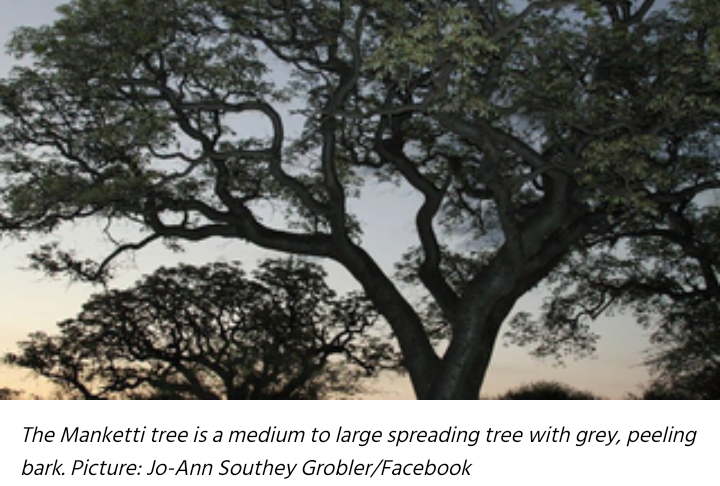A proposal by the Minister of Forestry, Fisheries, and the Environment Barbara Creecy will see four more trees added to the list of protected trees in South Africa.
According to the National Forests Act of 1998, “no person may cut, disturb, damage or destroy any protected tree or possess, collect, remove, transport, export, purchase, sell, donate or in any other manner acquire or dispose of any protected tree or any forest product derived from a protected tree, except under a license or exemption granted by the minister to an applicant and subject to such period and conditions as may be stipulated.
Contravention of this declaration is regarded as a first category offence that may result in a person who is found guilty of being sentenced to a fine or imprisonment for a period up to three years, or to both a fine and imprisonment.”
The minister intends to add four more species to South Africa’s list of protected trees, according to a Government Gazette published on Monday. The gazette called for public comment on the ministers’ proposal.
The gazette stated that these four species are “proposed for addition to the existing list of protected tree species after evaluation by an expert panel, on the basis, that they are keystone species and vulnerable to particular threats in specific parts of their distribution range.”
There are currently 48 listed protected tree species in South Africa as per the National Forests Act. The country boasts over 1 700 species of indigenous trees and shrubs, a few of which are classified as threatened due to their rarity as well as the pressure of commercial and subsistence use.
More than 70 trees and groups of trees have been declared national “Champion Trees” by the Department of Agriculture, Forestry and Fisheries. This means that these species are fully protected under the National Forests Act of 1998.
“The Champion Tree project aims to list and protect trees of national conservation significance. The project over the years has been about raising awareness for the national tree heritage, and to promote it as an asset for tourism,” the Department of Agriculture, Forestry and Fisheries stated.
The four trees to be added to the protected list are the Red Ivory, African Ebony or Jackal-Berry, Manketti tree or Mongongo nut and the Umtiza. The South African National Biodiversity Institute had the following to say about these trees:
Also knowns as Rooi-Ivoor or Rooihout in Afrikaans and umNcaka or umNini in isiZulu, the Red Ivory is “an evergreen to semi-deciduous tree that is drought resistant but not frost resistant. The tree normally grows in dense groups with other trees, reaching 15 m in height and is very attractive to birds. It is mostly found in the northern part of South Africa in the province of Limpopo, where local people sell the fruit on the street.” Wood from the tree has also been used to craft durable furniture, while its leaves and fruit are favoured by birds, bushbuck, and people alike.
This tree is also known as the Jackal-Berry, Jakkalsbessie in Afrikaans, Musuma in Tshivenda and Mgula in Tsonga. “It has a fantastic mutualism and symbiotic network with many living organisms, from human beings to small insects. There is a complex ecological system revolving around this tree. It is one of the savanna giants that can live for more than 200 years.” The African Ebony is a relatively tall tree, reaching heights of 25 metres with a large trunk circumference of over 5 metres. Flowers are cream-coloured and bell-shaped. Male flowers are arranged in stalked bunches and female flowers are solitary. The fruit is a fleshy berry, with an enlarged calyx, yellow to orange when ripe.
Manketti tree – Schinziophyton rautanenii

Also known as False Balsa and Mongongo Nut in English, Mundalama in Tonga, Mungongoma in Shona and Ngomwa in isiNdebele. This tree is a medium to large spreading tree with grey, peeling bark. Dark green leaves grow in a spiral formation and turn yellow before falling. The Manketti tree’s light grey-green fruits are covered in velvety hairs, while their hard seeds produce an edible oil.
Umtiza – Umtiza listeriana

Called Umtiza in English, Afrikaans and isiXhosa, this tree is “a genus of one species in the legume family, found in a small area of the Eastern Cape; a spiny tree with prominent glossy, dark green foliage, and a perfect feature tree for small gardens, or as a garden filler or screen.” A rare species, the Umtiza has only been recorded in 6 areas, some of which are no longer present. A major threat to these trees is the expansion of human settlements, particularly in the East London area, where informal settlements have cleared some of the tree’s habitat. The wood of the Umtiza is said to be quite hard and oily. It was used in the past to house propeller shafts in small boats, as the natural oil provided constant lubrication. Traditionally a sacred tree for the Xhosa people, who use it for protection against lightning and evil spirits, by hanging a piece of bark above the door.
